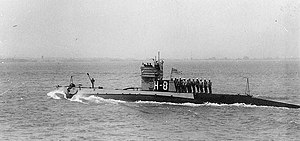USS H-8 (SS-151) was a H-class submarine originally built for the Imperial Russian Navy. Six of these were not delivered pending the outcome of the Russian Revolution of 1917 before being purchased by the United States Navy on 20 May 1918.
 USS H-8 underway, circa 1922
| |
| History | |
|---|---|
| Name | H-8 |
| Ordered | by the Imperial Russian Navy, 1915 |
| Builder | Puget Sound Navy Yard, Bremerton, Washington |
| Laid down | 25 May 1918 |
| Launched | 14 November 1918 |
| Acquired | 20 May 1918 |
| Commissioned | 18 November 1918 |
| Decommissioned | 17 November 1922 |
| Reclassified | SS-151, 17 July 1920 |
| Stricken | 26 February 1931 |
| Fate | Sold for scrapping, 28 November 1933 |
| General characteristics | |
| Class and type | H-class submarine |
| Displacement |
|
| Length | 150 ft 4 in (45.82 m) |
| Beam | 15 ft 10 in (4.83 m) |
| Draft | 12 ft 5 in (3.78 m) |
| Installed power |
|
| Propulsion |
|
| Speed |
|
| Range |
|
| Test depth | 200 ft (61 m) |
| Complement | 25 |
| Armament | 4 × 18-inch (450 mm) torpedo tubes |
Description
editThe H-class submarines had a length of 150 feet 4 inches (45.8 m) overall, a beam of 15 feet 10 inches (4.8 m) and a mean draft of 12 feet 5 inches (3.8 m). They displaced 358 long tons (364 t) on the surface and 467 long tons (474 t) submerged. The boats had a crew of 2 officers and 23 enlisted men. They had a diving depth of 200 feet (61.0 m).[1]
For surface running, they were powered by two New London Ship & Engine Co. 475-brake-horsepower (354 kW) diesel engines, each driving one propeller shaft. When submerged each propeller was driven by a 170-horsepower (127 kW) Electro Dynamic Co. electric motor. They could reach 14 knots (26 km/h; 16 mph) on the surface and 10.5 knots (19.4 km/h; 12.1 mph) underwater.[1] On the surface, the boats had a range of 2,300 nautical miles (4,300 km; 2,600 mi) at 11 knots (20 km/h; 13 mph) and 100 nmi (190 km; 120 mi) at 5 knots (9.3 km/h; 5.8 mph) submerged.[2]
The boats were armed with four 18-inch (450 mm) torpedo tubes in the bow. They carried four reloads, for a total of eight torpedoes.[2]
Construction and career
editH-8 was launched on 14 November 1918, three days after the signing of the Armistice with Germany, and commissioned on 18 November 1918. From there she sailed to San Pedro, California, where she was attached first to Submarine Divisions 6 and 7 (SubDivs 6 and 7). Operating with her sister ships, H-8 engaged in extensive battle and training exercises out of San Pedro, varying this routine with patrols off Santa Catalina Island. In company with SubDivs 6 and 7, and tender Beaver, H-8 departed San Pedro on 25 July 1922 and arrived in Norfolk, Virginia on 14 September. She decommissioned there on 17 November. Her name was struck from the Naval Vessel Register on 26 February 1931. She was sold for scrapping on 28 November 1933.
Notes
editReferences
edit- Friedman, Norman (1995). U.S. Submarines Through 1945: An Illustrated Design History. Annapolis, Maryland: Naval Institute Press. ISBN 1-55750-263-3.
- Gardiner, Robert & Gray, Randal, eds. (1985). Conway's All the World's Fighting Ships 1906–1921. Annapolis, Maryland: Naval Institute Press. ISBN 0-85177-245-5.
- This article incorporates text from the public domain Dictionary of American Naval Fighting Ships. The entry can be found here.
External links
edit- PigBoats.COM H-class page
- Photo gallery of USS H-8 at NavSource Naval History